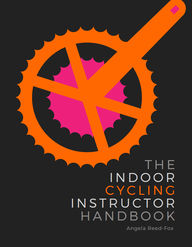by Angela Reed-Fox Safe and effective sprinting in indoor cyclingThe one indoor cycling manoeuvre which causes the most injuries (and litigation) appears to be 'sprinting'. But effective sprinting is safe - what we've found it that sprinting is frequently coached wrongly or badly, putting riders at risk of injury. What sprinting is not Sprinting is not having riders pedalling as fast as they can. We've seen examples of instructors asking riders to match an unsafe foot speed (regardless of the ability, fitness, and coordination of the rider), getting riders to compete against each other to see who can go the furthest (using the bike's distance metric) or having riders competing to pedal the fastest. The above practices (and others) promote riders pedalling with insufficient resistance; with the fixed flywheel construction of the stationary bike, this means they are more likely to lose control of the bike, putting them at risk of horrible injury. What sprinting is
What happens as Sagan decides to attack? 1. He adds on gears This is similar to us adding on resistance - but on a road bike, when you add gears, it means every push of the pedal will get your nearer to the finish line. Instantly he's making it harder to pedal. 2. He positions himself Moving his seat closer to the nose of the saddle, he's shifting his weight forward on the bike. This means he can power down on the pedals more efficiently because he's shifting further ahead of the crankarms which means he can recruit more power from those big muscle groups. 3. He picks up the pace Then he's ready to fire. Added to the steps he's already taken, when he increases the cadence and fires forward. What does that mean for you instructing a sprint? First of all, it means there's a definite order. Although Greipel employed these steps in a second, he'd be adding cadence onto resistance, not the other way round. For him, that would mean he's wasting energy with a faster cadence at a lower resistance, but in the studio where we have a fixed wheel setup and no actual finish line, it's more about safety. We keep our riders safe by always ensuring that they have sufficient resistance for their ability, their level of fitness, and the cadence they're pedalling. Coaching different positions on the bike is great not just for seasoned veterans, but also for new riders who will welcome their bodyweight being shifted to a different part of their undercarriage! We'll be recruiting muscles differently when we shift to a different position. In the clip, Sagan looks like he's pedalling at about 100-110rpm (approx). That's a vast difference from some of the unsafe craziness that occurs in studios. Why doesn't he pedal faster? Because he's pedalling against an immense resistance and he knows his most efficient cadence when sprinting. As a general rule of thumb in the studio, if your rider can manage 120rpm, that rider needs to add resistance. What would happen if Peter Sagan did a dangerous 'studio sprint' in this situation? Well what would happen would be he'd pick up the pace and reduce the resistance (we've seen that happen) so essentially his power output would drop, as his cadence increased. He would be overtaken. His legs would be flapping wildly as he pedals in his 'granny' gear while his opponents would quickly flock past him snatching glory from him well before the finish line. He'd probably lose his place on the team for the next season, and therefore miss out on lots of lucrative sponsorship deals too. See, it's just not worth it! How should you coach the sprint? Remember that we are aiming at both a safe and an effective sprint, otherwise there's no benefit to the rider - and there's risk of injury when done incorrectly.
Indoor cycling instructor? Click below for free CPD resources. Your venue can also receive information on how we can help improve customer registration, retention, engagement and profitability.
0 Comments
Leave a Reply. |
Categories
All
|
Quick links
Get started
|
Find what's right for you
|
Courses
|
Further learning
|
More
|
The Indoor Cycling Institute provides the most comprehensive and up to date indoor cycling instructor training; providing entry-level courses, and further education to raise the standard of instructors.
© 2014-2024 Protheorem Ltd
The Indoor Cycling Institute is owned and operated by Protheorem Ltd Registered in England & Wales, Company number 12812092
The Indoor Cycling Institute is owned and operated by Protheorem Ltd Registered in England & Wales, Company number 12812092




